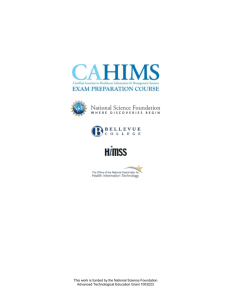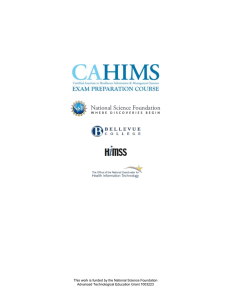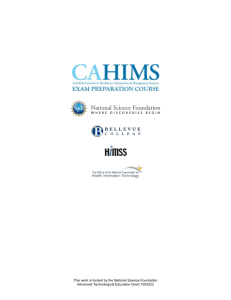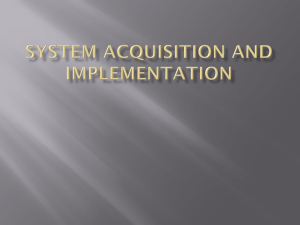4.2-Assessment-Key
advertisement
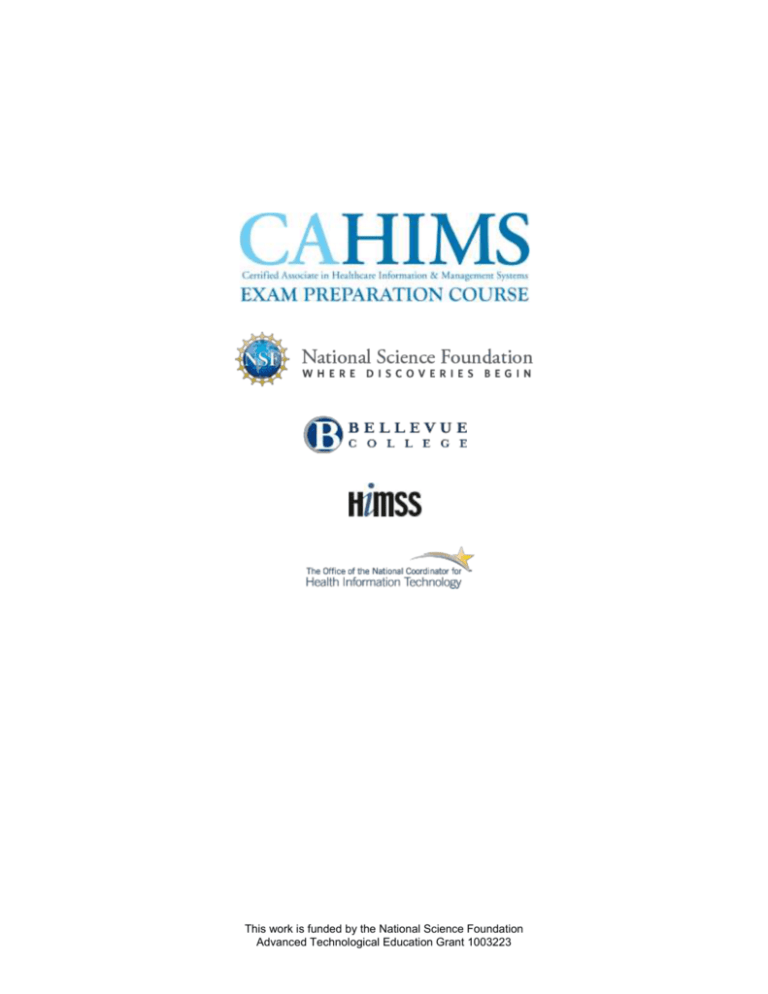
This work is funded by the National Science Foundation Advanced Technological Education Grant 1003223 The CAHIMS Exam Preparation Course and the CAHIMS exam are the result of collaboration between the Life Science Informatics Center at Bellevue College and the Healthcare Information and Management Systems Society (HIMSS). Significant content found in the CAHIMS Exam Preparation Course stems from the Office of the National Coordinator for Health Information Technology. Creation of the CAHIMS Exam Preparation Course and the CAHIMS exam was made possible through support from the National Science Foundation (NSF). Curriculum Team: Margaret Schulte, DBA Michèle Royer, PhD Nathan Savage, MLIS This work is funded by the National Science Foundation Advanced Technological Education Grant 1003223 Section 4 - HIMS Selection and Acquisition Lesson 4.2 - Systems Acquisition Assessment Questions Answer Key Lecture 1 1. What is one suggestion to consider when forming a EHR selection committee? *a. Invite “movers and shakers” onboard in the decision-making process. b. Invite patients on your committee. c. Exclude as many top administrators as possible since their skill set with regards to EHR systems is often too limited. d. Be sure to limit physician input only to relevant topics such as workflow. Answer: a. Invite “movers and shakers” onboard in the decision-making process. Lecture(s)/Slide(s): 1/4 2. Functional Requirements can best be defined as: *a. those processes that you want a system to perform. b. the attributes of the system as a whole or its environment. c. the requirements needed for the hardware to function. Answer: a. Functional requirements can best be defined as those processes that you want a system to perform. These can be discussed as an overview or can be analyzed in great detail. Lecture(s)/Slide(s): 1/8 3. What does HL7 stand for? *a. Health Level 7 b. High Load 7 c. EHR Code of ethics guaranteeing safety Answer: a. Health Level 7. Lecture(s)/Slide(s): 1/11 4. Which are recommended steps for using HL7 as a baseline for your EHR requirements? a. Learn the language: Understand how key words are used within the model. b. Review and select relevant sections relevant to your healthcare setting. This work is funded by the National Science Foundation Advanced Technological Education Grant 1003223 Page 1 c. Understand that no organizational structure exists to the document as it is meant to be loosely interpreted. *d. Both a and b Answer: d. Both a and b. c is incorrect as the document has a definite hierarchical structure divided into three sections. Lecture(s)/Slide(s): 1/12-13 5. What is a use case? a. Background information including organization size and specialty and current systems and hardware in place. *b. A technique for documenting the potential requirements of a new system or any type of system change. c. The defined learning curve for users/ administrators. d. Both a and c Answer: b. A technique for documenting the potential requirements of a new system or any type of system change Lecture(s)/Slide(s): 1/14 6. What is NOT something typically found in a RFP? a. System Implementation plan b. Proposed costs c. Shorter development time *d. Institution’s financial statement Answer: d. Institution’s financial statement Lecture(s)/Slide(s): 1/17-18 7. Though the number or order of these steps is not set in stone, we suggested this number of steps for your selection process: a. 6 b. 10 *c. 12 d. 24 Answer: c. 12 steps Slide(s): 1/2-3 This work is funded by the National Science Foundation Advanced Technological Education Grant 1003223 Page 2 Lectures 2 & 3 8. What are the steps in the initial planning and project development for an EHR implementation? a. identifying stakeholders b. determining appropriate members for a steering committee c. develop a strategic plan *d. all of the above Answer: d. All of the above. Initial steps include identifying stakeholders, determining appropriate members for a steering committee, developing a strategic plan, and developing a timeline for electronic health record selection and implementation Lecture(s)/Slide(s): 2/3, 4, 6-12 9. What kind of people need to be represented in the implementation project team? a. clinicians b. technologists c. administrators *d. all of the above Answer: d. all of the above. Students should be able to identify multidisciplinary participants such as clinicians, technologists, and administrators Lecture(s)/Slide(s): 2/7 10. A needs assessment helps to identify the critical aspects of EHR utilization that will drive implementation. *a. True b. False Answer: a. True. A needs assessment can determine the scope of project, identify if constituent units in an organization will individually determine their own needs, and identify the critical aspects of EHR utilization that will drive implementation. Lecture(s)/Slide(s): 2/10 This work is funded by the National Science Foundation Advanced Technological Education Grant 1003223 Page 3 11. Which of the following are examples of functional requirements? a. EHR is Certification Commission for Health Information Technology (CCHIT) certified b. EHR is HIPAA compliant c. EHR meets meaningful use criteria and is eligible for incentives *d. all of the above Answer: d. all of the above. Students should be able to enumerate some of the key functional requirements Lecture(s)/Slide(s): 2/13 12. A workflow analysis enables assessment of how work is being done in an organization. *a. True b. False Answer: a. True. A workflow analysis allows examination of how work is done in an organization, and maps clinical as well as non clinical workflows. Lecture(s)/Slide(s): 2/14 13. True or false? A gap is another type of workflow analysis. a. True *b. False Answer: b. False. A gap analysis allows examination of the steps needed to transition from the current state (pre-implementation) to the future state (postimplementation). Lecture(s)/Slide(s): 2/14, 15 Lectures 4, 5 & 6 14. According to the lecture, which means is the best way to insure top management approval of software application? a. Dutifully research the latest products that address the problem to be solved b. Allow the expert CIO and the Information System team to evaluate and select software *c. Use a multidisciplinary team to evaluate and select a software system that addresses the needs of all areas affected by the initiative This work is funded by the National Science Foundation Advanced Technological Education Grant 1003223 Page 4 d. Maintain high levels of executive oversight for computer hardware and software system selections Answer: c. Use a multidisciplinary team to evaluate and select a software system that addresses the needs of all areas affected by the initiative Lecture(s)/Slide(s): 4/14 15. In Overcautious Community, Oklahoma there has been a recent outbreak of an infectious disease which is spreading rapidly. Subsequently, there is more public demand for a software system which provides speedy results for lab tests. This scenario best demonstrates which of the following factors in the process of purchasing HIT systems? *a. Time b. Money c. Resources d. None of the above Answer: a. Time Lecture(s)/Slide(s): 4/11 16. The CIO of a health organization has been informed that new government regulations require reports formatted in a manner in which the current operating system does not support. In order to comply with regulations and meet the new reporting formats, new software is needed. This is an example of which of the following purchasing factors for HIT systems? *a. External pressures b. Congruency between overall strategic goals and IT strategic planning c. Resource acquisition d. Competition Answer: a. External pressures Lecture(s)/Slide(s): 4/7 17. A multidisciplinary computer system selection and evaluation team would consist of all of the following EXCEPT: a. an executive oversight member b. a functional representative of the primary affected area c. a technical representative *d. a customer service representative of the prospective vendor This work is funded by the National Science Foundation Advanced Technological Education Grant 1003223 Page 5 Answer: d. a customer service representative of the prospective vendor Lecture(s)/Slide(s): 4/14-18 18. All of the following are benefits of including a functional owner on an evaluation and selection team within a state-owned healthcare facility EXCEPT: a. understanding of the day-to-day functions that the new system will replace *b. assurance of successful implementation c. knowledge of the workflow of the organization d. knowledge of the current system’s capabilities Answer: b. assurance of successful implementation Lecture(s)/Slide(s): 4/16 19. Healthcare Facility First has determined that it needs a new computer hardware system but it cannot afford to dedicate the man hours needed to implement the best system for their needs. According to the lecture, which option represents the best solution for their problem? a. Update the current operational systems and renegotiate the current contract b. Schedule conferences with peer organizations CIO’s to evaluate and select the necessary computer system *c. Hire consultants to provide the evaluation and selection groundwork d. Schedule educational demonstrations of possible products for the Information Services team Answer: c. Hire consultants to provide the evaluation and selection groundwork Lecture(s)/Slide(s): 4/18 20. Through which of the following tools would an organization learn the most about a potential vendor? a. RFI *b. RFP c. RFQ d. Quick Bid Answer: b. RFP Lecture(s)/Slide(s): 5/5-8 This work is funded by the National Science Foundation Advanced Technological Education Grant 1003223 Page 6 21. Which of the following aids would be most useful when purchasing a complex and extremely costly IT system? a. Customer reference call *b. Site visit c. Peer recommendations d. Consulting firm’s report Answer: b. Site visit Lecture(s)/Slide(s): 5/12-16 22. According to the lecture, which of the following is the primary purpose of the scripted demonstration scenario? a. to narrow down the choices of vendors to two or three b. to determine the financial viability of the vendor *c. to evaluate the product in relation to specific functionality d. to reduce the vendor’s ability to disguise weaknesses in their products Answer: c. to evaluate the product in relation to specific functionality Lecture(s)/Slide(s): 5/17-18 23. Which of the following cannot be considered as a capital expense? a. the development of training materials b. software in which the license is purchased c. hardware *d. staff training Answer: d. staff training Lecture(s)/Slide(s): 5/21 24. The members of the negotiating team should include all EXCEPT: (a/an) a. Finance team member *b. CEO c. Owner/user d. Evaluation team member Answer: b. CEO Lecture(s)/Slide(s): 6/4 This work is funded by the National Science Foundation Advanced Technological Education Grant 1003223 Page 7 25. According to the lecture, which of the following decreases the negotiating team’s leverage? a. neglecting to document discussions prior to and during negotiations b. having a willingness to walk away from negotiations c. maintaining friendly relationships with the prospective vendor *d. alluding to the vendor’s ranking in the competition Answer: d. alluding to the vendor’s ranking in the competition Lecture(s)/Slide(s): 6/6 26. According to the lecture, which of the following is the critical factor when deciding between dual thread negotiations and single thread negotiations? a. Realistic expectations for vendors *b. Time deadlines c. Regulatory requirements d. Software versus hardware needs Answer: b. Time deadlines Lecture(s)/Slide(s): 6/10, 11 27. Which of the following best describes the purpose of a boilerplate contract? a. to simply state the terms of a complex contract *b. to provide an advantageous contract for one party c. to provide a base point to start negotiations d. to define the contested issues in a contract Answer: b. to provide an advantageous contract for one party Lecture(s)/Slide(s): 6/15 28. Which of the following is the best reason to read every IT contract? *a. to assure an advantageous system and service for the organization b. to understand the limits of liability c. to assess the project’s impact on market value d. to be able to track the budget of the project Answer: a. to assure an advantageous system and service for the organization Lecture(s)/Slide(s): 6/16-17 This work is funded by the National Science Foundation Advanced Technological Education Grant 1003223 Page 8 29. Which of the following options provides the best solution when dealing with a vendor on negative issues after a deal is made? *a. Beneficial “out” clauses within the contract b. Third party negotiators c. Long-term friendly relationships between the organization and the vendor d. Documentation of the negative issues and attempted resolutions Answer: a. Beneficial “out” clauses within the contract Lecture(s)/Slide(s): 6/19 This work is funded by the National Science Foundation Advanced Technological Education Grant 1003223 Page 9

